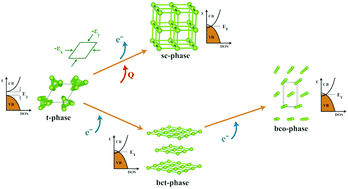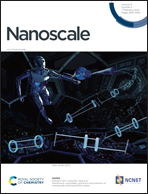Temperature, strain and charge mediated multiple and dynamical phase changes of selenium and tellurium†
Abstract
Semiconducting selenium and tellurium in their 3D bulk trigonal structures consist of parallel and weakly interacting helical chains of atoms and display a number of peculiarities. We predict that thermal excitations, 2D compressive strain and excess charge of positive and negative polarity mediate metal–insulator transitions by transforming these semiconductors into different metallic crystal structures. When heated to high temperature, or compressed, or charged positively, they change into a simple cubic structure with metallic bands, which is very rare among elemental crystals. When charged negatively, they transform first into body-centered tetragonal and subsequently into the body-centered orthorhombic structures with increasing negative charging. These two new structures stabilized by excess electrons also have overlapping metallic bands and quasi 2D and 1D substructures of lower dimensionality. Since the external charging of crystals can be achieved through their surfaces, the effects of charging on 2D structures of selenium and tellurium are also investigated. Similar structural transformations have been mediated also in 2D nanosheets and free-standing monolayers of these elements. These phase changes assisted by phonons are dynamical, reversible and tunable; the resulting metal–insulator transitions can occur within very short time intervals and may offer important device applications.



 Please wait while we load your content...
Please wait while we load your content...